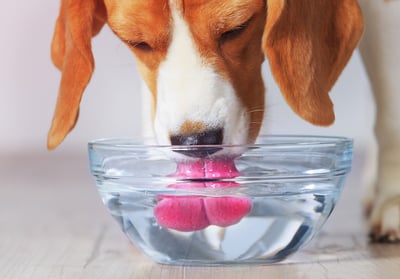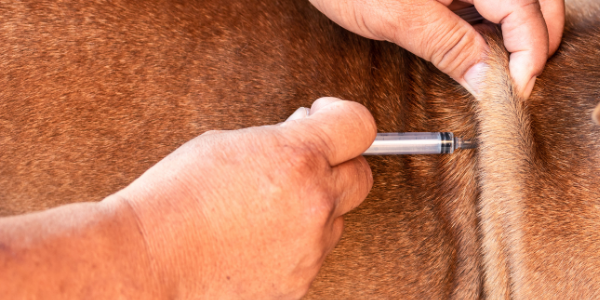- en
Your dog has diabetes. It's a lifelong condition, but it is manageable, and your dog can live comfortably.
This pet information prescription will help you know what to do, how to make your dog more comfortable, and how to help reverse the effects of diabetes.
Quick Links

Diabetes is a disease of the pancreas. The symptoms you notice are related to the elevation of glucose in the blood and the body’s inability to use the glucose as a source of energy.
Reports from 2016 show an upward trend in the disease's prevalence, with it rising nearly 80% over a 10-year-period. Of the dogs with diabetes, 99% have what is called diabetes mellitus or sugar diabetes. Dogs can have either Type 1 diabetes mellitus (also called insulin-dependent, which is most common) or Type 2 diabetes mellitus (also called non-insulin-dependent – seen mostly in older obese dogs).
Our mission is to help save dogs' and cats’ lives through our educational content. To support our efforts, this page may contain affiliate links. We earn a commission for qualifying purchases – at no cost to you.
Diabetes mellitus occurs when your dog’s body either produces too little insulin or stops responding to the insulin that is produced. Insulin is required to transfer glucose (sugar) from the bloodstream into the cells, where it can be broken down and used as energy. When there is not enough insulin, glucose levels can reach high levels causing illness.
Pet owners typically notice that their dog has increased hunger, thirst, and urination. Many dogs lose weight, and some develop cataracts that eventually impair their vision. In advanced cases of diabetes, dogs can experience a lack of energy, vomiting, and not wanting to eat.
The cause of this disease depends on which type of diabetes your veterinarian diagnoses. In type 1 diabetes, which is most common in dogs, they do not produce enough insulin, whereas, in type 2 diabetes, dogs don’t respond to insulin correctly.
Approximately 1 in 300 dogs will be diagnosed with diabetes in their lifetime. Those prone to diabetes include dogs between the ages of 4–14 and unspayed females. Unfortunately, breeds such as cocker spaniels, toy poodles, retrievers, miniature schnauzers, and terriers are more prone to this disorder.
In addition to breed, age, and sex, health conditions like Cushing's disease or pancreatitis can lead to diabetes, as can excessive weight, and long-term steroid use.
Follow your veterinarian’s instructions on administering medication (if prescribed) and diet. Most dogs will be prescribed injectable insulin that will need to be given under the skin daily. Few dogs can be managed with a prescription diet alone.
If your pet requires insulin injections, your veterinary care team will instruct you on how to store, prepare, and give your dog their shots.
Most insulins need to be kept in the fridge and rolled gently to mix (Vetsulin® is different – it needs to be shaken until a milky consistency is obtained). Confirm with your veterinarian as to whether you should be gently rolling or shaking the vial. Do this step before drawing the insulin up in the syringe.
After drawing up the insulin, be sure there are no air bubbles or gaps in the insulin before injecting), and then give under the skin by lifting up a small "skin tent" and injecting it. Hold your dog's skin with one hand and the needle in the other. Be sure to pull back the plunger (there should be a little resistance if you haven’t gone through the skin) before injecting to ensure there is no blood present before injecting.
*NOTE* If insulin is kept in the fridge, allow the insulin to reach room temperature before injecting. After you have taken the vial out of the fridge, visibly inspect it for any clumps or white particles – inspect it again after gently rolling – if there are clumps or particles, trash the insulin.
*NOTE* It is best not to inject from the base of the neck to over the shoulder blades because the absorption of insulin is often less in those areas. It's best to choose a spot between the midback and the base of the tail, including on the sides (over ribs) and the flanks. They can also inject over the thighs. Also, you need to change up the location of the injections every few days.
*NOTE* Insulin is only good for 28 days once opened and used. Discard after 28 days to be sure the product has optimal function.
Most dogs don't even notice after a few days of receiving their injections, and particularly don't mind if they're eating a tasty snack at the time of their injection! Never give insulin if your dog appears weak or has skipped a meal since this could lower their blood sugar too much.
It can often take a few weeks and multiple trips to the vet for blood tests to find the exact amount of insulin needed for your dog. You will need to closely monitor your dog’s food consumption as you should only give insulin if your pet has eaten (otherwise, blood sugar could drop too low). However, check in with your veterinarian to confirm, as it may be OK to give a ½ dose. You’ll also need to keep a close eye on how much they’re drinking and going to the bathroom, but this should improve significantly once the diabetes is under control.
Your veterinarian may ask you to do some glucose level monitoring at home by using a glucometer. Some veterinarians can place a temporary skin sensor that can obtain a real-time glucose reading.

The best thing you can do is to use the medication and diet your veterinarian prescribed and keep a close eye on your dog’s eating, drinking, and urination habits.
Because they are more thirsty, make sure they have plenty of access to fresh water at all times. You should also plan to take your pup outside to use the bathroom at least every 3–4 hours until their diabetes is under control.
*NOTE* Due to possible glucose spillover into your pet’s urine, your dog may develop a urinary tract infection (UTI). If you notice that other symptoms are improving, but your dog needs to go out even more often to pee, or they’re peeing just a small amount, contact your veterinarian because they may need to test your dog's urine.
You should notice a decrease in your dog’s hunger, thirst, and urination amount.
You will hopefully notice that your dog is more active and feeling more like themselves as well.

If at any point your dog appears unconscious, weak and no energy, or wobbly (almost as if they are drunk), apply some Karo or corn syrup to their gums and get them to a veterinarian right away. Signs like this indicate your dog’s blood glucose has gotten too low.
If your dog is still overly hungry, still drinking a lot more than normal, or peeing more than normal after 2 weeks, let your veterinarian know as they may need to adjust your dog’s insulin dosage.

For most dogs, diabetes is a lifelong disease requiring daily insulin. In very rare cases, diabetes can be “reversed,” meaning the dog will no longer require insulin. If this does happen, your dog will need to stay on a specific diet and maintain a lean weight to prevent a relapse. Your veterinarian will be able to walk you through this process and can recommend a diet with ideal protein and carbohydrate levels.
You must not change diet or insulin dosage without consulting your veterinarian first.

The Pet InfoRx® is made possible, in part, through our partnership with AlignCare®.


© Preventive Vet. All rights reserved. PreventiveVet.com
